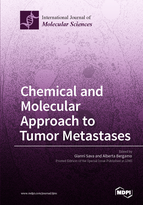Chemical and Molecular Approach to Tumor Metastases
A special issue of International Journal of Molecular Sciences (ISSN 1422-0067). This special issue belongs to the section "Biochemistry".
Deadline for manuscript submissions: closed (31 October 2017) | Viewed by 106854
Special Issue Editors
Interests: pharmacology; metastasis; solid tumors; metal-based drugs; drug development
Interests: : pharmacology; metastasis; tumor microenvironment; metal-based drugs; integrins
Special Issue Information
Dear Colleagues,
Malignant tumors develop distant metastases, e.g., small clusters of cells that detach from the primitive site and colonize distant organs and tissues. Unlike the primary masses, metastases are often difficult to fully eradicate by surgery ablation and are almost always the primary object of chemo- and/or immune-therapies. The presence of metastases at tumor diagnosis is responsible for the unfavorable prognosis and of relapses even after initially successful tumor therapies. The lack of success of chemo- and immune-therapy approaches depends on many factors among which, the inadequate capacity of the anti-tumor drugs of reaching appropriate concentrations in the organs and tissues involved in the metastatic growth is a major concern. Another factor is the complexity of the metastasis biology and of their molecular behavior, evidencing a population of tumor cells with a genetic compartment different from that of the tumor of origin. The involvement of host cells and factors recruited by the metastatic cells and committed to support the metastatic growth is also an event crucial for the lack of success of the anti-tumor therapy. The knowledge of the molecular biology of metastases is mandatory to support the search for chemical agents to treat the metastatic determinants and to control of the neoplastic disease.
This Special Issue on “Chemical and Molecular Approach to Tumor Metastases” will explore the impact of biology, molecular medicine and chemistry on all aspects related to tumor metastases from the biological and molecular aspects of the metastatic growth, including the relationships between the metastatic cells and the host environment, and the search for druggable determinants useful for the chemical analysis of agents selectively active against tumor metastases.
With the combination of invited reviews and original papers from prominent scientists working on all aspects of molecular medicine and cancer therapy, such as, but not limited to: drug delivery, genomics, chemoprevention, drug discovery, we aim to sample recent progress in molecular and chemical aspects of therapy of malignant tumors. Clinical success studies and evidences of novel compounds are particularly welcome.
Prof. Dr. Gianni Sava
Dr. Alberta Bergamo
Guest Editors
Manuscript Submission Information
Manuscripts should be submitted online at www.mdpi.com by registering and logging in to this website. Once you are registered, click here to go to the submission form. Manuscripts can be submitted until the deadline. All submissions that pass pre-check are peer-reviewed. Accepted papers will be published continuously in the journal (as soon as accepted) and will be listed together on the special issue website. Research articles, review articles as well as short communications are invited. For planned papers, a title and short abstract (about 100 words) can be sent to the Editorial Office for announcement on this website. Submitted manuscripts should not have been published previously, nor be under consideration for publication elsewhere (except conference proceedings papers). All manuscripts are thoroughly refereed through a single-blind peer-review process. A guide for authors and other relevant information for submission of manuscripts is available on the Instructions for Authors page. International Journal of Molecular Sciences is an international peer-reviewed open access semimonthly journal published by MDPI.
Please visit the Instructions for Authors page before submitting a manuscript.
There is an Article Processing Charge (APC) for publication in this
open access journal. For details about the APC please see here.
Submitted papers should be well formatted and use good English. Authors may use MDPI's
English editing service prior to publication or during author revisions.
Keywords
- tumor metastasis
- biology of metastasis
- genomics of metastasis
- epigenetics of metastasis
- dynamics of metastasis
- metastasis niche
- microenvironment
- immunotherapy
- chemotherapy
- molecular approaches
- chemical approaches
- metastasis druggable targets
- innovative drugs
- clinical studies








